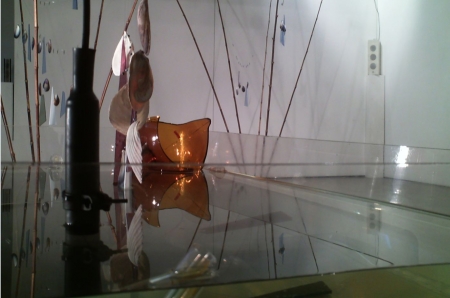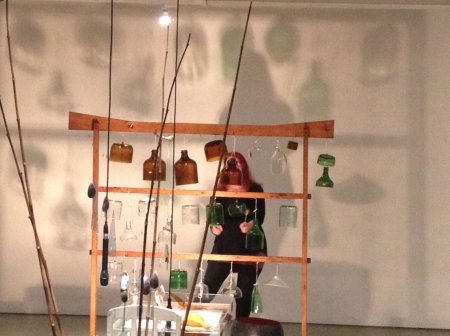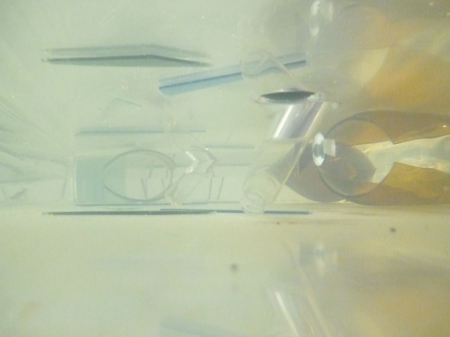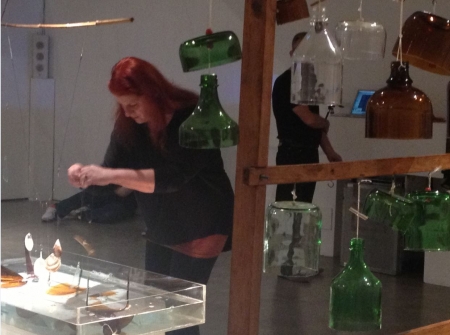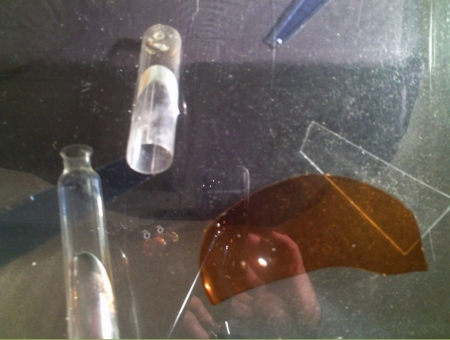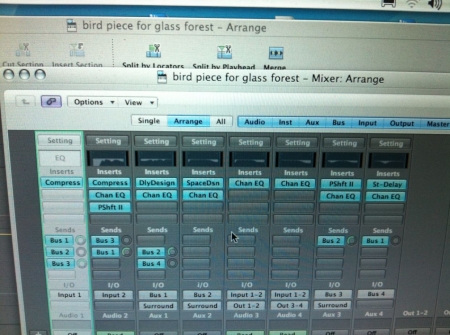- accueil >
- Numéros de la revue >
- Musique et écologies du son. Propositions pratique... >
- Artistes de l’écologie du son >
Artifice and Integration as Design Considerations in the Creation of Sound Installations and Site-Specific Environmental Music
Ros BandtDOI : https://dx.doi.org/10.56698/filigrane.700
Résumés
Abstract
Two major case studies, 2013 residencies, the indoor urban Floating Glass sound art exhibition, November-January, and the remote outdoor JaaraJaara Project lasting the full year, will be contrasted and compared with a view to showing different design modalities integrating sound, ecology and art. The intentions of both sounding artworks are framed by the respective physical, acoustic and ecological systems each location possesses. Floating Glass was designed for a stark white urban gallery in central Melbourne is designed to enhance visual art and show off the prowess of the "artist" as designer and executant. By way of contrast and scale, the 55 acres of land for wild life in the JaaraJaara Central Victorian bushlands, is a unique natural box-ironbark woodlands environment, a habitat with complex botanical, bird, animal and human activity. It is in the process of regenerating after colonial pastoralism, the gold rushes, hobby farms and is now an acoustic sanctuary celebrating indigenous knowledges and landcare. What and how does the sound artist want to contribute to the already complex relationships of sound, ecology and acoustic space in these locations?
These two different case studies, Floating Glass and the JaaraJaara Seasons highlight aspects of the design process rarely analysed in the art or musical worlds. How much should we introduce and change the environments we design for? What are the intended outcomes? Will it be lasting? Is the artifice created transportable? Who is it for? What is its ecological impact? How sustainable is the artwork? What is its ecological footprint? How important are aesthetics, innovation, the new? Who is the arbitor? : The organisor, the funder, the artist, the critic, or the audience? Both works, Floating Glass and JaaraJaara Seasons exist as individual solutions to these questions. They are unique and very different aggregates of both artifice and integration, terms that help to analyse complex artistic constructs and new sonic habitats.
Texte intégral
1Every place is an acoustic space with its own particular sounds, reflections and contextual soundscape. Intervening and changing a space as a sound artist requires great sensitivity and respect for the existing environment as sonic habitat. Responsibility must also be taken for the changes brought about to the context as a result of the artistic intervention. Constructing sounding artworks requires many decisions to realise a new sonic reality in a place, decisions which will only be fully realised with an intimate knowledge of the spatial and acoustic properties of the venue. The extent to which the place is changed visually and audibly as well as socially varies with each work. How much do we subvert and how much do we maintain? How does sound art blend or mutate the space it inhabits? Using the terms artifice and integration it is possible to interrogate design principles at work in creating sounding artworks and events and to analyse aspects of creation often overlooked.
Artifice is the action of the artist or constructor. It is the product of art, constructive skill. (The Shorter Oxford Dictionary Vol 1, OUP, 103)
Integration is the making up of the whole by adding together or combining the separate parts or elements to make whole, entire. (The Shorter Oxford English Dictionary, Vol 1, OUP, 1021)
These terms, artifice and integration are not mutually exclusive but the way they relate together provides a fresh entree into understanding how and why new sounding artworks are constructed. Two different sounding art projects created in 2013 in two different locations, the city gallery and the outdoor 55 acres of bushland are case studies in which we can analyse these terms at play. Overtly it would seem the gallery construction Floating Glass Exhibition would be more artificial and the bush JaaraJaara Seasons would favour integration and to a large extent this is so. However, on closer examination of each work, it is clear that the dichotomous relationship of the terms is not rigid even in one work, but fluid and changing according to shifting parameters of sound and the environment, the spatial directions of sound, the number of people in the space, the length of time stayed and the changing conditions of the venue, day night, weather.
2Floating Glass was an installation and exhibition created during a three month residency in 2012-13 in a resonant white rectangular gallery with a small video theatrette. The entire gallery was a dedicated acoustic and visual space for the entire time. It was an empty space, waiting for my artificial creation. My aim was to generate a beautiful sounding world generated from glass in all its forms, floating in the air, on and under water, still and moving, installed and performed. Visual glass sculptures and invisible glass moving sounds would be designed into a new sonic world, taking the visual into the temporal and changing every day, see example 1.
Example 1. Floating Glass, an urban gallery immersive exhibition with performances
3Floating Glass was designed as an exhibition, an artificially constructed immersive room of sounding, floating playable glass sculptures, surround sound and realtime processing which constantly changed according to the position of the listener. A digital glass forest of three large bamboo tree sculptures with sounding glass leaves could be played by the performer and audience.
Example 2. VIDEO: Floating Glass Performances filmed by Green Brain Media www.youtube.com/watch?v=tSLh4ajBz9M
4In defining the design parameters, limiting the materials to glass for the sculptures affected the timbres of the potential sound palette considerably. Grainy brittle and resonant sounds were emitted from the glass trees contrasting the bell-like glass sounds of the two glass vertical marimbas, the elaborate vertical Flagong sound sculpture and the baby Flagonita with their suspended recycled cut bottle bells.
Example 3. Playable glass sculpture: The Flagong, a vertical glass marimba
5The Glass was a unifying factor integrating all elements both visually illuminated and sonically performed and recorded. A transparent water tray contained shards of broken coloured glass and small objects such as pipettes, and tiny glass bubbles which could be moved by the performer around the submerged hydrophone and underwater camera.
Example 4a. The water tray, a laboratory of experiment.
See also video on line Vimeo.com/57192724
6Kinetic stained glass watery forms overlaid and changed as the different colours and shapes collided, sinking in the water. As the suspended windchime sculpture was lowered into the tray the glass shards altered their pitches due to the different conductors, air and water.
Example 4b. Elasticised playable windchime component which could play gliding tones.
7Gliding tones were played as a musical instrument. See example 4b.Visually watching the action of the floating re-combining the forms from my actions was mesmerising, a new form of three dimensional coloured glass art. See example 4c.
Example 4c. Moving coloured glass art in the water tray. Sounding scores.
8The sound signals were captured by the hydrophone and sent to the computers with Logic patches which morphed the sound, creating many artificial layers from the initial sounds in the tank. These were further designed to spread spatially through the room in real time using a 5.1 playback system and two subwoofers. The tray was a central point for on-going scientific experiment. Every day new experiments were made investigating the behaviour of glass in water and air. These sounds changed as they spread new journeys through the room via designed reverberation, equalisation, ring modulation and multi tracking, sonic processes which had never been heard in this space before. Many live and electro-acoustic compositions were made as a result of these experiments. I wanted to share the joy of having such a unique artificial sound environment to create audio-visual sounding artworks with others, so I gave 6 free concerts in the summer, a beautiful time to listen to these cooling water sounds. The programmes for these are published online at rosbandt.wordpress.com. The room was a changing pool of lit glass reflections ricocheting around the room, especially the glass leaves on the trees which moved and sounded acoustically most of the time even with the air currents. The shadows and reflections were part of the pieces and became kinetic visual elements like scores. This encouraged me to develop the visual aspects of the works using as small video projector camera, and an underwater camera to capture some of these beautiful ephemeral moments. The sound and light became integrated in unpredictable ways.
The glas water tray reminded me of an inanimate aquarium of sound and light. The idea of creatures living in aquariums as trapped playthings sourced a range of videos from Yabbies to Seahorses which I filmed on location in commercial aquariums and brought into the space, projecting their movements on the walls, on the side of the water tray's box pedestal, and in the theatrette. Sonic Jellies, is a five movement video work recently played at the Athens Video festival was screened in the theatrette with sounds composed on the flagong using the jellies movements as a kinetic score. Other films of underwater creatures were used in live performance in the concerts and also screened on loops on different days in the theatrette during the exhibition period. They were also projected diagonally in a long triangle on the wall of the gallery from time to time..
As a composer I was stunned at the rich sonic habitat I was living in that I was continually creating. The moving audio-visual sound environments inspired me to make new works. A hydrophone recording of a fish I had recorded in the waters of the Yerebatan cistern in Istanbul, swam from speaker to speaker across the various possible planes of the speaker array. It was wonderous, sometimes comic. For the performances I also brought in other instruments: the tarhu a bowed spike- fiddle for pieces like Polar Bear entrapped on ice, and recorders for digitally repeating bird sounds for The Digital Glass Forest (published on the JaaraJaara Seasons CD sonic gallery). Many composed and improvised sonic fluctuations were possible in this artifically rich sonic environment. Videos and new works were performed from the experiments over three months, with a free concert every week of newly created works. (See website for the six programmes www.rosbandt.wordpress.com) The freedom to create had no restrictions. Elaborate constructions had no boundaries save for the overall volume levels from time to time to accommodate adjoining arts workers in nearby studios Floating Glass was a designed and changing audience participatory sonic ecosystem, a room for reflection and experiencing sound with the entire body in a visceral and poetic way. In one sense I was able to create any artificial construct I desired. What eventuated was an immersive room with an ever-changing and growing ecology of glass compositions which developed in an integrated way over the three months. These works could only come about in this immersive construction, dependent on their artifice becoming a unique, integrated live electronic sounding environment.
Example 5. A constructed computer-controlled immersive interactive environment in 5.1
9The Jaara Jaara Project is so named after the JaaraJaara aboriginal people who once populated Central Victoria Australia. Situated in 55 acres of land for wildlife, adjoining a state forest, this remote soundscape of the box- iron bark woodlands of central Victorian bushland provides a distinct natural ecosystem in which to work. It became a laboratory for investigation and interpretation over the course of a year. I took the chance to analyse and probe deeper into the remnant post goldfields woodlands as an exploratorium, recording in the air and water, interpreting all aspects of tree life as it is today, understanding the history and understory of the region with elders, artists, scientists, pastoralists, miners, musicians and locals. From this information, cross media artworks were created in sound, sculpture, mixed media installation, radiophonic composition and performance, on site, on air and online. A digital acoustic sanctuary on line reveals the many layers of this land; indigenous, pastoral, post gold rush, economic, telematic.
Example 6. Dedicated website for JaaraJaara Seasons, a 12 month calendar for the seven indigenous seasons. This digital acoustic sanctuary is online at hearingjaarajaara2013.wordpress.com
10This on line website allows the global community to come to know the sonic ecology of the seven major aboriginal seasons of this country in a much more detailed land -based way than the four Western seasons offer. The habitat can be experienced through the senses of listening and looking as well as reading through the photos videos and statements. It is a multimedia book I created with Minako Kanda.
The electro-acoustic work JaaraJaaraSeasons is an audio by-product of this intense environmental immersion over twelve months. Ithas seven movements composed with the natural soundscapes recorded at the appropriate time. The names of the movements reflect the changes observed over the year. The composed sound is intimately integrated with the soundscape recordings and takes all its tempo, timbres and densities from what was actually observed and heard on site.
11JaaraJaaraSeasons: Seven Movements
1.Dryground-January /February
Bush is tinder dry. Cicadas, tree frogs and parrots define their territory. Ancient voices emerge from Jaara Jaara woodland. Elders are here to remind us to care for country together.
2.Eel-March
Symphony of underwater creatures recorded with hydrophone in the dam. Water tank is empty – an enormous drum.
3.Wombat-April/May/June/July
Owlet nightjar shelters from torrential rain. Winter nostalgia in lamplight and fire, thinking of home – Ireland, Australia and China. Magpies reflect. Deafening frogs flushed out early from heavy rain. The milkyway is overhead.
4.Orchid- August
Exquisite tiny orchids appear one after another. Golden wattles explode the bush
5.Tadpole-September/October
Dams full of wildlife. Pobblebonk frogs polyphony calling from pond to pond. Kookaburras announce the last wattles and chocolate lilies. Bonfire celebrating the end of winter at the equinox.
6.Butterflies-November
Grasses start to flower. Butterflies flutter in the warm air. Bird chorus accompanies. Dragonflies dart.
7.Grass-December
Brittle grasses, cicadas and skinks in hot breezes. Orion strung in the sky. Yellow-tailed black cockatoos predict thunder. Corellas pierce the setting sun.
This work is published on CD by Sonic Gallery along with two other tracks, The digital glass forest, track 8, where a soundscape recording is put through the artificial environment of the Floating Glass exhibition, see example 5 and track 9, Dawn Birds, Acoustic Sanctuary. Audio excerpts from all of these tracks can be heard on the CD Menu of the jaarajaara website, (hearing jaarajaara2013.wordpress.com).
It is available from http://www.hearingplaces.com.
12In order to share the unique sound environment of this acoustic habitat I designed a public event to hear JaaraJaara Seasons performed live with seven multi-cultural musicians in a 5.1 surround sound environment spread over many acres. The audience walked a kilometre into the site and were free to move between the 5 listening stations where enormous speakers were suspended high in the eucalyptus trees in the vicinity of each amplified musician. These were Ron Murray (didjeridoo) Rick Nelson (welcome, clapsticks and voice) and Sarah James (voice and celtic violin), Mary Doumany (Australian/Lebanese harpist), WangZheng Ting, (Chinese Sheng player), Le Tuan Hung, (Vietnamese Dan Tranh ) and myself Ros Bandt (Flutes, air whistles, recorders, psaltery and Tarhu, an original Australian Bowed spiked fiddle). See example 7

Example 7. Tuning to each other before separating into individual sound stations deep in the bush
13This assembled multi-cultural and indigenous group is an interesting portrait of the multi-cultural nature of this area's long and recent history. It was an attempt to show musically the kind of sounds which could have been heard here, with a wish to blend, to integrate with the cultural history. Rick and Ron had a special contribution to make being indigenous. We can learn from them. Integration was also high on my list for wanting the composed sound to blend with the natural soundscape. The imported sound system, though artificial in itself was used to integrate the performed and recorded sounds subtly in the bush with the live mix from engineer Jim Atkins monitoring the subtle balance of radio mikes, surround and the composed work with each moment as the sun, rain and frogs also performed.

Example 8. The CD JaaraJaara Seasons by Ros Bandt
14Each musician responded in their cued sections. Each knew the composed sound well before the event, and was free to articulate with the sounds of the day. Despite the hundreds of cables, huge speakers, engineer and solar-power generator, the environment was not subverted but enhanced. The 5.1 playback and live mix pouring the areas identity back into the same acoustic environment produced some revelatory resonances and sympathetic aural waves not possible anywhere else. Everyone who came experienced this hearing JaaraJaara country with fresh ears. The public could wander between the musicians through the bush sound stations hearing natural bushland rhythms and indigenous phonemes of lost languages, live multi-cultural responses to the land and the composed electro-acoustic mix. The aeolian harp sound sculpture was defining the site as an acoustic sanctuary for the first time. (See JaaraJaara website and also blog, rosbandt.wordpress.com for more images of its installation). You can never predict the wind and whether you will hear sound or not. You have to be there and wait. Naming this land the acoustic sanctuary was a conscious decision to share and encourage people to listen to country more closely and attentively, hearing the small changes happening around them. Australia is a sung country defined by the songs created and owned by its first cultural custodians. Hearing JaaraJaara helped us all to feel a part of the land and to appreciate the beauty and detail present in this box ironbark habitat. The acoustic sanctuary is feeding into this cosmology. As Aunty Alice, Mutti Mutti elder told me in the world heritage site of Lake Mungo where we first put the harps, "the sounds of the wind in the strings are reaching right back to the dreamtime. Its a good thing."

Example 9. Rick Nelson ( JaaraJaara descendent), Ron Murray, didjeridoo (Mutti Mutti /Wambawamba) playing in the aeolian harps (Ros Bandt with Steve Naylor and Redcliffs community) on the performance day in the acoustic sanctuary in central Victoria.
15The sounds that are present or absent in a place are signs of the health of the nation. Sound is an awesome barometer. Sounds heard can communicate imposition, artificiality, but they may also also disappear, blend or enhance the existing sonic habitat. Sounds are part of our intangible cultural heritage linking us to the ancient continuities of the Australian aborigines. As we share land knowledge we can share greater understanding of the longest continuing culture on earth. The impossibility of integrating these stories and oral continuities is very stark in the young nation of immigrant cultures since colonisation. The generosity of the JaaraJaara Rick Nelson and Ron Murray WembaWemba and Mutti Mutti. (neighbouring aboriginal nations and JaaraJaara resident) was astounding at the opening welcome to country. See example 9.You can feel the force of their connection to country in the JaaraJaara video on the website. Go to home and scroll down for a dense online profile of this event. Hundreds of people walked into the performance after their greeting. The weather seemed to contain every season as you can see from the website photos. Heritage archivist Melinda Barrie is still interviewing participants about their responses to this event and has submitted it for an intangible cultural heritage Advocacy award. The artifice of a colonial award and the small beginnings towards cultural integration here, present a truthful profile of the challenges and provocations for everyone who has chosen to be in this ancient land. This event however crossed these bridges and the ongoing feeling in the region has been lasting and quite euphoric. Posters are still on the trees a year later. Many urban and regional radio stations spread the word and played the piece. The local Fryerstown school provided the much needed front of house for cars and refreshments nearby for the walk into country. Not a single piece of litter was found on the property. The respect for country was total. Everyone treaded softly. Integration and sharing the precious acoustic was a key to the many layers of integration taking place, electro-acoustic, cultural, artistic, musical, personal. Some people lay on the ground in one spot and reported amazing experiences from the sounds, both crafted and natural, shifting up and around them, and through the valley. One person was not sure when the magpies were in the speakers or in the trees. Even the flute imitations of the birds, live and recorded were directly transcribed from the resident magpies. (Magpie for Ruth Wilkinson, recorded in Cortona, heard in wombat season July on the hearing jaarajaara online calendar.) This match enhanced the wonder and beauty of the event. The sounds were so integrated into the space there was no division between natural, performed or recorded at many points in the fifty five minute piece.
16In comparing and contrasting these two recent sounding artworks, Floating Glass and JaaraJaara Seasons, some general design correlates can be found in both works. Each is a place where the dichotomous relationship between artifice and integration is played out.
1.Outside and inside as acoustic spaces, defined acoustic habitats.
2.The decision to use technological systems, (multi-channel sound recording, Logic and reaper, multi tracking, Effects, Post production) are pliable introduced systems capable of being programmed to integrate space /time /sound relationships but can also be used for disruption and the unexpected, especially when operated during the performance (concert 6 Gloating Glass and Jaara Jaara public performance).
3.Original sound sculptures, artificial constructions.
4.Live realtime performance, solo, group
5.Composed spatial music, speaker arrays and planned audience pathways.
6.Live musical responses in the spaces.
7.The intention to set up complete sound habitats as immersive environments, natural or artificial.
8.Diverse sound pathways for the auditor.
9.Public concerts to mark out special moments in these works of long duration, Floating Glass 3 months, 6 concerts, JaaraJaara 12 months i public event 12 month calender.
10.Website documentation to spread the sounds globally but advocating intehgration at the local level.
11.Complex relationships between music, sound, society, environment and subjectivity.
12.Audience interaction and contribution to the work.
17In summary Floating Glass and JaaraJaara Seasons are independent combinations of all of the above. Each work shows the decisions that have been made with regard to each of the 12 points above. Many are common. The indoor /outdoor and the town /country contrasts however are perhaps the most influential. The site and the specificity of what is appropriate and possible in each venue in terms of acoustic space as habitat was a key feature. The durational considerations possible on each site as a working laboratory and public access influenced the degree of integration and artificiality possible at each point. The artist must be the arbiter caretaking the sensitive and aesthetic concerns so that an artistically rewarding work ensues. In the thousands of decisions which have to be made to create large scale events such as these it is helpful to have conceptual yardsticks such as artifice and integration to keep being mindful of the creative process, its potential and its chosen outcomes. Taking one part of JaaraJaara into the gallery's artifice pushed this dichotomy to an extreme disjunction with interesting artistic outcomes. (Track 8 of CD). Many things are possible. Floating Glass no longer exists in its physical form. The Acoustic sanctuary and the aeolian harps remain in the bush singing country in the winds. Both works continue to exist in many digital forms, CD radiophonic pieces, on line and a dedicated website, and in the air. The works are artificial constructs firmly rooted in integrating new relationships between sound art, ecology and society.
Bibliographie
BANDT Ros (2001) : Sound Sculpture : Intersections in sound and sculpture in Australian artworks. Craftsman House, Fine Arts Press
BANDT, Ros. Duffy, Michelle & McKinnon, Dolly. 2009, Hearing Places, Cambridge Scholars Publishing, Newcastle on Tyne, UK
http://www.c-s-p.org/Flyers/Hearing-Places–Sound–Place–Time-and- Culture1-4438-0111-9.htm
BANDT, Ros. Hearing Australian Identity, audio visual paper http://www.sounddesign.unimelb.edu.au/site/NationPaper/NationPaper.html
BANDT, Ros. Artifice and Integration as design considerations in creating site specific sounding environments, Floating Glass in the art gallery and the Jaara Jaara bush projects compared. Paris May 27 2013 Son Et Ecologie Conference Universitaire 8. French powerpoint PDF online.
Discography
Ros Bandt Glass and Clay, Move Records, Tracks 1, 3, 6
Ros Bandt JaaraJaaraSeasons, Sonic Gallery, Track 7, "Digital Glass Forest"
URLS
1. hearingjaarajaara2013.wordpress.com an audio visual 12 month calendar . Go to home and keep scrolling down.
2.rosbandt.wordpress.com a blog of photos of all recent events including both of these works fully covered.
3.hearingplaces.com JaaraJaara CD and other CDs by Ros Bandt are available here. This site is a centre for environmental sound art projects and resources, co founded with Leah Barclay.
4.http://www.australianmusiccentre.com.au/event/floating-glass-ros-bandt
5.http://thelibraryartspace.blogspot.com.au/2012/12/floating-glass-ros-bandt.html
6. www.rosbandt.com
Citation
Auteur
Quelques mots à propos de : Ros Bandt


